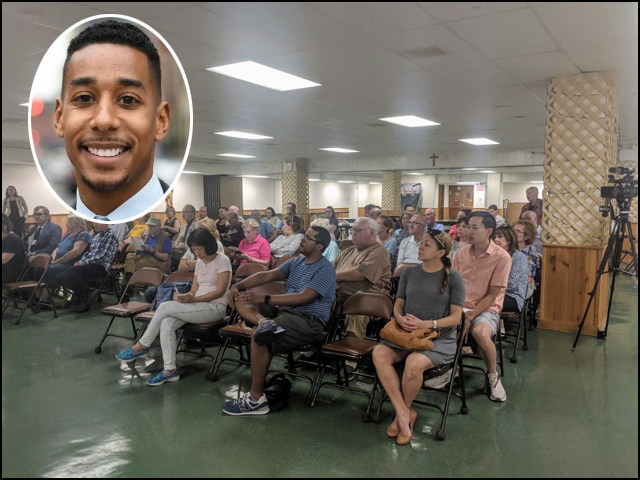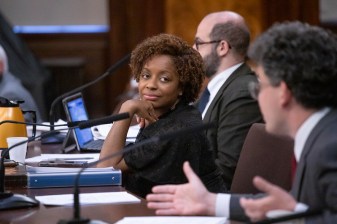Pedal Power: City Council Bill Might Speed Up Bike Lane Installation


A new City Council bill that could speed up the process of installing bike lanes is in danger of ending up in the dust bin of history if current lawmakers don’t get their act together before their term ends on Dec. 31.
The bill by Brooklyn Democrat (and incoming Brooklyn Borough President) Antonio Reynoso would repeal a notorious 2011 law that requires the Department of Transportation to notify community boards 90 days before installing or removing a bike lane — and then wait an additional 45 days after a community board hearing before doing the work.
That regulation was pushed by then-Council Member Lew Fidler on the specious grounds that bike lanes were so controversial that they needed more review than so-called “major transportation projects,” which, despite the name, can be undertaken merely by giving the local Council member 10 days to to submit comments and 30 days for a local community board to ask for a presentation on the project.
But in the 10 years since that bill, New Yorkers have embraced cycling and livable streets. For instance, per polling from Data For Progress, 58 percent of respondents said they supported changing streets to make it safe enough for children to bike to school, even if it meant removing parking or closing streets to car traffic.

The DOT’s own polling in a Citywide Mobility Survey from last October showed that only 13 percent of New Yorkers were opposed to allocating street space for protected bike lanes, with a whopping 68 percent in support of the idea (see page 37).
Reynoso’s bill would throw out the 2011 bill’s classification of bike lanes to consider them the same as any other “major transportation project” and therefore put community outreach and the installation of bike lane proposals on the same timeline as other street upgrades. Bike lanes would then exist under the definition other street projects that go in front of community boards: a project which “after construction will alter four or more consecutive blocks, or 1,000 consecutive feet of street, whichever is less, involving a major realignment of the roadway, including either removal of a vehicular lane(s) or full time removal of a parking lane(s) or addition of vehicular travel lane(s).”
“My bill strikes a balance between preserving mechanisms for community engagement while also streamlining and shortening the process for installing life-saving infrastructure,” Reynoso said. “Residents deserve opportunities for input on land-use decisions in their communities, including the installation of bike lanes. However, we also know that a bike lane can be the difference between life and death. Therefore, we need to ensure that once approved, bike lanes are installed as expeditiously as possible — my bill will help our city do that.”
The bill would not completely change the dynamic in which the DOT sometimes gets bogged down in trench warfare over each and every bike lane project proposed across the city. But it would at least remove an artificial barrier that’s been in the way of quicker bike lane implementation since Fidler’s law was signed.
Thanks to the growing popularity of cycling as well as the thirst for fewer car-choked public spaces, Mayor-elect Eric Adams did not face a backlash after earning a StreetsPAC endorsement on the strength of his promise to install 300 miles of protected bike lanes. Advocates say the polling and the election results are proof that the days of tiptoeing around every bike lane project should be left in the past.
“The current laws on the books are a relic, completely unfair and can delay life saving streets projects,” said Transportation Alternatives Communications Director Cory Epstein. “While New York City faces the bike boom, but also a rise in fatal crashes, we need to ensure that there’s no unnecessary delays in doing the projects that need to happen. Passing this measure is a common sense, first step to thinking differently about community engagement, and making sure the process is efficient and effective.”
Reclassifying bike lane projects to put them on the same timeline as other transportation projects would not only rationalize the way that the city approaches street design and do away with the arbitrary distinction stapled to the bike lane planning process. It could also prove extremely necessary to meet the goals laid out under the Streets Master Plan. The plan identifies 54 different bike lane proposals classified as “2022 locations” alone.
As Reynoso points out, the need to put in an average of 50 miles of protected bike lanes per year between 2022 and 2026 doesn’t really allow for archaic timelines.
“My bill will help speed up the process of rolling out bike lanes by cutting out the unnecessary and arbitrary 45-day waiting time that is currently part of the process, and by allowing DOT to present on bike lanes on the same timeline as it does for other master plan-related projects – like street redesigns and bus lanes,” said Reynoso.
The bill would also fit into the de Blasio administration’s own 2019 Green Wave agenda, which stated that “DOT will work with the Council to introduce and pass legislation to streamline Community Board notice and presentation requirements and eliminate the waiting period after a public hearing takes place, to implement life-saving interventions in a more reasonable time frame.”
At the moment, the DOT is not taking a position on the bill, which makes sense, given that its likelihood of passing is low (it was not discussed at the final Transportation Committee meeting of the year on Wednesday). But if it passes in the usual tsunami of bills at the end of a legislative session, the de Blasio administration might be willing to change the law as his successor arrives at City Hall.
“We look forward to reviewing this legislation,” said DOT spokesperson Seth Stein.
